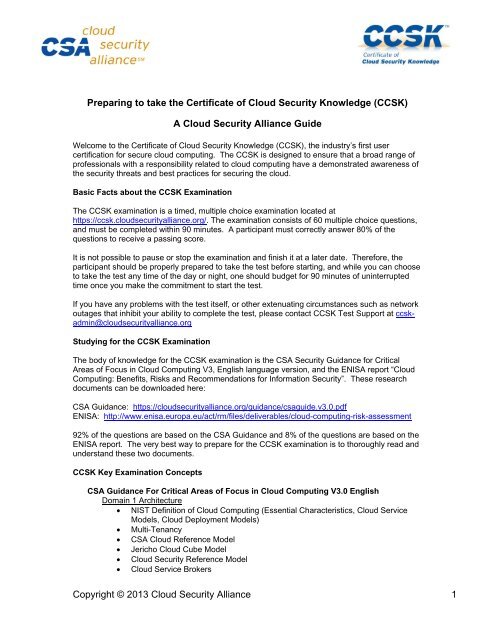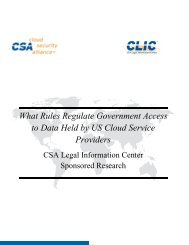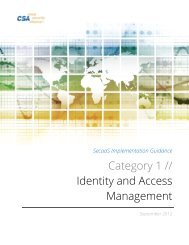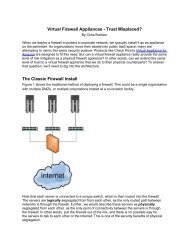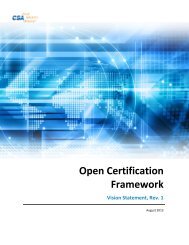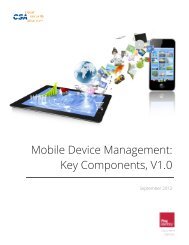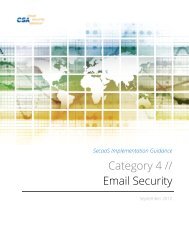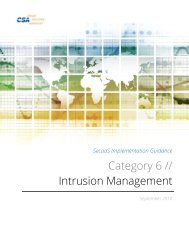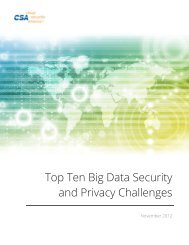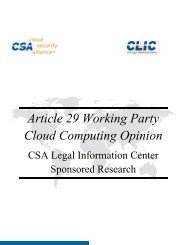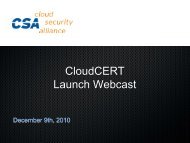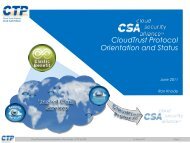CCSK Preparation Guide - Cloud Security Alliance
CCSK Preparation Guide - Cloud Security Alliance
CCSK Preparation Guide - Cloud Security Alliance
Create successful ePaper yourself
Turn your PDF publications into a flip-book with our unique Google optimized e-Paper software.
Preparing to take the Certificate of <strong>Cloud</strong> <strong>Security</strong> Knowledge (<strong>CCSK</strong>)<br />
A <strong>Cloud</strong> <strong>Security</strong> <strong>Alliance</strong> <strong>Guide</strong><br />
Welcome to the Certificate of <strong>Cloud</strong> <strong>Security</strong> Knowledge (<strong>CCSK</strong>), the industry’s first user<br />
certification for secure cloud computing. The <strong>CCSK</strong> is designed to ensure that a broad range of<br />
professionals with a responsibility related to cloud computing have a demonstrated awareness of<br />
the security threats and best practices for securing the cloud.<br />
Basic Facts about the <strong>CCSK</strong> Examination<br />
The <strong>CCSK</strong> examination is a timed, multiple choice examination located at<br />
https://ccsk.cloudsecurityalliance.org/. The examination consists of 60 multiple choice questions,<br />
and must be completed within 90 minutes. A participant must correctly answer 80% of the<br />
questions to receive a passing score.<br />
It is not possible to pause or stop the examination and finish it at a later date. Therefore, the<br />
participant should be properly prepared to take the test before starting, and while you can choose<br />
to take the test any time of the day or night, one should budget for 90 minutes of uninterrupted<br />
time once you make the commitment to start the test.<br />
If you have any problems with the test itself, or other extenuating circumstances such as network<br />
outages that inhibit your ability to complete the test, please contact <strong>CCSK</strong> Test Support at ccskadmin@cloudsecurityalliance.org<br />
Studying for the <strong>CCSK</strong> Examination<br />
The body of knowledge for the <strong>CCSK</strong> examination is the CSA <strong>Security</strong> Guidance for Critical<br />
Areas of Focus in <strong>Cloud</strong> Computing V3, English language version, and the ENISA report “<strong>Cloud</strong><br />
Computing: Benefits, Risks and Recommendations for Information <strong>Security</strong>”. These research<br />
documents can be downloaded here:<br />
CSA Guidance: https://cloudsecurityalliance.org/guidance/csaguide.v3.0.pdf<br />
ENISA: http://www.enisa.europa.eu/act/rm/files/deliverables/cloud-computing-risk-assessment<br />
92% of the questions are based on the CSA Guidance and 8% of the questions are based on the<br />
ENISA report. The very best way to prepare for the <strong>CCSK</strong> examination is to thoroughly read and<br />
understand these two documents.<br />
<strong>CCSK</strong> Key Examination Concepts<br />
CSA Guidance For Critical Areas of Focus in <strong>Cloud</strong> Computing V3.0 English<br />
Domain 1 Architecture<br />
NIST Definition of <strong>Cloud</strong> Computing (Essential Characteristics, <strong>Cloud</strong> Service<br />
Models, <strong>Cloud</strong> Deployment Models)<br />
Multi-Tenancy<br />
CSA <strong>Cloud</strong> Reference Model<br />
Jericho <strong>Cloud</strong> Cube Model<br />
<strong>Cloud</strong> <strong>Security</strong> Reference Model<br />
<strong>Cloud</strong> Service Brokers<br />
Copyright © 2013 <strong>Cloud</strong> <strong>Security</strong> <strong>Alliance</strong> 1
Service Level Agreements<br />
Domain 2: Governance and Enterprise Risk Management<br />
Contractual <strong>Security</strong> Requirements<br />
Enterprise and Information Risk Management<br />
Third Party Management Recommendations<br />
Supply chain examination<br />
Use of Cost Savings for <strong>Cloud</strong><br />
Domain 3: Legal Issues: Contracts and Electronic Discovery<br />
Consideration of cloud-related issues in three dimensions<br />
eDiscovery considerations<br />
Jurisdictions and data locations<br />
Liability for activities of subcontractors<br />
Due diligence responsibility<br />
Federal Rules of Civil Procedure and electronically stored information<br />
Metadata<br />
Litigation hold<br />
Domain 4: Compliance and Audit Management<br />
Definition of Compliance<br />
Right to audit<br />
Compliance impact on cloud contracts<br />
Audit scope and compliance scope<br />
Compliance analysis requirements<br />
Auditor requirements<br />
Domain 5: Information Management and Data <strong>Security</strong><br />
Six phases of the Data <strong>Security</strong> Lifecycle and their key elements<br />
Volume storage<br />
Object storage<br />
Logical vs physical locations of data<br />
Three valid options for protecting data<br />
Data Loss Prevention<br />
Detection Data Migration to the <strong>Cloud</strong><br />
Encryption in IaaS, PaaS & SaaS<br />
Database Activity Monitoring and File Activity Monitoring<br />
Data Backup<br />
Data Dispersion<br />
Data Fragmentation<br />
Domain 6: Interoperability and Portability<br />
Definitions of Portability and Interoperability<br />
Virtualization impacts on Portability and Interoperability<br />
SAML and WS-<strong>Security</strong><br />
Size of Data Sets<br />
Lock-In considerations by IaaS, PaaS & SaaS delivery models<br />
Mitigating hardware compatibility issues<br />
Copyright © 2013 <strong>Cloud</strong> <strong>Security</strong> <strong>Alliance</strong> 2
Domain 7: Traditional <strong>Security</strong>, Business Continuity, and Disaster Recovery<br />
Four D's of perimeter security<br />
<strong>Cloud</strong> backup and disaster recovery services<br />
Customer due diligence related to BCM/DR<br />
Business Continuity Management/Disaster Recovery due diligence<br />
Restoration Plan<br />
Physical location of cloud provider<br />
Domain 8: Data Center Operations<br />
Relation to <strong>Cloud</strong> Controls Matrix<br />
Queries run by data center operators<br />
Technical aspects of a Provider's data center operations customer should<br />
understand<br />
Logging and report generation in multi-site clouds<br />
Domain 9: Incident Response<br />
Factor allowing for more efficient and effective containment and recovery in a<br />
cloud<br />
Main data source for detection and analysis of an incident<br />
Investigating and containing an incident in an Infrastructure as a Service<br />
environment<br />
Reducing the occurrence of application level incidents<br />
How often should incident response testing occur<br />
Offline analysis of potential incidents<br />
Domain 10: Application <strong>Security</strong><br />
identity, entitlement, and access management (IdEA)<br />
SDLC impact and implications<br />
Differences in S-P-I models<br />
Consideration when performing a remote vulnerability test of a cloud-based<br />
application<br />
Categories of security monitoring for applications<br />
Entitlement matrix<br />
Domain 11: Encryption and Key Management<br />
Adequate encryption protection of data in the cloud<br />
Key management best practices, location of keys, keys per user<br />
Relationship to tokenization, masking, anonymization and cloud database<br />
controls<br />
Domain 12: Identity, Entitlement, and Access Management<br />
Relationship between identities and attributes<br />
Identity Federation<br />
Relationship between Policy Decision Point (PDP) and Policy Enforcement Point<br />
(PEP)<br />
SAML and WS-Federation<br />
Provisioning and authoritative sources<br />
Domain 13: Virtualization<br />
<strong>Security</strong> concerns for hypervisor architecture<br />
Copyright © 2013 <strong>Cloud</strong> <strong>Security</strong> <strong>Alliance</strong> 3
VM guest hardening, blind spots, VM Sprawl, data comingling, instant-on gaps<br />
In-Motion VM characteristics that can create a serious complexity for audits<br />
How can virtual machine communications bypass network security controls<br />
VM attack surfaces<br />
Compartmentalization of VMs<br />
Domain 14: <strong>Security</strong> as a Service<br />
10 categories<br />
Barriers to developing full confidence in security as a service (SECaaS)<br />
When deploying <strong>Security</strong> as a Service in a highly regulated industry or<br />
environment, what should both parties agree on in advance and include in the<br />
SLA<br />
Logging and reporting implications<br />
How can web security as a service be deployed<br />
What measures do <strong>Security</strong> as a Service providers take to earn the trust of their<br />
customers<br />
ENISA <strong>Cloud</strong> Computing: Benefits, Risks and Recommendations for Information<br />
<strong>Security</strong><br />
Isolation failure<br />
Economic Denial of Service<br />
Licensing Risks<br />
VM hopping<br />
Five key legal issues common across all scenarios<br />
Top security risks in ENISA research<br />
OVF<br />
Underlying vulnerability in Loss of Governance<br />
User provisioning vulnerability<br />
Risk concerns of a cloud provider being acquired<br />
<strong>Security</strong> benefits of cloud<br />
Risks R.1 – R.35 and underlying vulnerabilities<br />
Data controller vs data processor definitions<br />
in Infrastructure as a Service (IaaS), who is responsible for guest systems<br />
monitoring<br />
If you do not pass the test…<br />
Test participants will receive two opportunities to pass the test. While you may take your second<br />
attempt as soon as you wish, we highly recommend studying the source material again prior to<br />
taking the test. Because of question randomization, you may see a very different exam with<br />
mostly different questions.<br />
Copyright © 2013 <strong>Cloud</strong> <strong>Security</strong> <strong>Alliance</strong> 4


